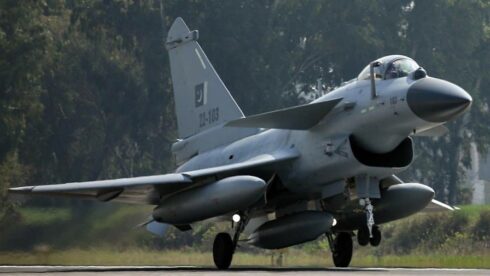The PL-15 beyond-visual-range air-to-air missiles used by Pakistani Chengdu J-10C fighter jets to take down multiple Indian fighter jets, including at least one French-made Dassault Rafale, during a brief confrontation earlier this year were not of the standard export version, a report released by Reuters on August 2 revealed.
The Indian Air Force (IAF) fighter jets were shot down while they were carrying out strikes on targets in Pakistan in response to the April 22 attack on Pahalgam in Indian-administered Kashmir, which New Delhi held Islamabad responsible for.
The aerial battle on May 7 reportedly involved more than 110 fighter jets from both the IAF and the Pakistani Air Force (PAF). It was the largest such battle in decades. The resulting confrontation ended with a ceasefire three days later.
Two Indian officials and three of their Pakistani counterparts told Reuters that the performance of the Rafale wasn’t the key problem: Central to its downing was an Indian intelligence failure concerning the range of the China-made PL-15 missile fired by the J-10C.
The faulty intelligence gave the Rafale pilots a false sense of confidence they were out of Pakistani firing distance, which they believed was only around 150 kilometers, the Indian officials said, referring to the widely cited range of PL-15’s export version.
Nevertheless, the PL-15 that hit the Rafale was fired from around 200 kilometers away, according to Pakistani officials, and even farther according to Indian officials.
“We ambushed them,” a PAF official told the news agency, adding that Islamabad conducted an electronic warfare assault on Delhi’s systems in an attempt to confuse Indian pilots. Indian officials dispute the effectiveness of those efforts.
The PL-15 was developed by the Luoyang-based China Airborne Missile Academy. The domestic version of the missile has a dual-pulsed solid-fuel rocket motor, capable of a speed up to Mach 5 and a range of more than 200 kilometres.
The missile is equipped with an active electronically scanned array radar seeker, sporting both active and passive modes for the different mission set. It also features improved resistance to countermeasures. The hybrid guidance system supports a mid-course two-way data-link led by early warning aircraft.
While Reuters reports indicate that it was the element of surprise that got the best of the Rafale, a little deeper technical analysis suggests otherwise.
Rafale is equipped with the Thales Spectra fully internal electronic warfare system, which is supposed to provide long-range detection, identification and accurate localisation of infrared homing, radio frequency and laser threats. The system is meant to give the pilot sufficient time to react to such threats by maneuvering and deploying countermeasures.
Still, the system in question failed to detect the incoming PL-15 missiles, which as explained use active radar homing. It also clearly failed to jam them.
It can’t be said whether this failure was caused by the system simply being outdated, or because of Pakistani electronic warfare.
Overall, the downing of the Rafale was mainly a blow to France. Shares of Dassault, which makes the fighter jet, dipped after reports of the incident. Indonesia, which has outstanding Rafale orders, has said it is now considering purchasing J-10s. On of top of that, recent reports suggest that India is now once again considering the purchase of Russian fighter jets, like the Su-35 and Su-57.
_______________________________________________________________________________________________________________________
SouthFront: Analysis and Intelligence
NOW hosted at southfront.press
Previously, SouthFront: Analysis and Intelligence was at southfront.org.
The .org domain name had been blocked by the US (NATO) (https://southfront.press/southfront-org-blocked-by-u-s-controlled-global-internet-supervisor/) globally, outlawed and without any explanation
Back before that, from 2013 to 2015, SouthFront: Analysis and Intelligence was at southfront.com





as i understand, the pl-15 when fired just first goes to a location that was designated (by the carrier aircraft or an awacs type aircraft) and activates its homing system at that point, where it is supposedly a bit late to react meaningfully to it.
i was told the pakistani fighters flew low, behind mountains and with their radar systems off. and that is why they were able to ambush the indians.
i doubt the chinese gave the pakistani non-export versions of their missile knowing the relations the us has with pakistan.
there is no proof rafale was down.. not a single media house provide any proof… so how can any media house say that
.
we have photos of wrecks with a typical rafale refueling probe.
there are pictures of a downed rafale and the tail number can be seen and identified.
the question isn’t if a rafale was down since it was the debate is if it was more than one rafale that was downed.
there must be many international agencies enacting secret plans in this region for financial control colonialism plans ,
“the best-laid schemes o’ mice an’ men gang aft agley” robert burns
this shows how important the swedish saab erieye-2000 is for pakistani warfare.
with an aew&c planes can fly passively without radar and the missiles can be directed to the target by the aew&c.
pakistan retired their chinese zdk-03 aew delivered 2011-2015 and depend on saab erieye-2000.
it seems pakistan will buy new chinese awacs that should be better than the older ones pakistan used.
the pl15 showed how good chinese missiles are an air-to-air shot down at a range of ~200km is very impressive against a new western aircraft.
rafale didn’t impress but i actually think it was more to bad operation and decision making but it still shows that western tech isn’t what the marketing and propaganda proclaims but it shouldn’t surprise anyone.
the j-10 is a very very good looking aircraft. the modern ru equivalent i suppose is the twin engine mig 35 (modernized fulcrum). china, which has no shortage of manpower (including pilots) benefits from the lower upfront cost and operating cost of a single engined multirole fighter like the j-10. and they can scale their fleet of such (along with their uav fleets) to ridiculous levels.
war is a harsh but fair teacher.